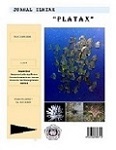Biodiversity and Biomass of Macroalgae in Kotania Bay Waters, West Seram
DOI:
https://doi.org/10.35800/jip.2.2.2014.7150Abstract
Research on biodiversity and biomass of macroalgae in Kotania Bay waters, West Seram, Mollucas was conducted on July and August 2010. There were 20 species of macroalgae collected, in which 8 species were green algae (Chlorophyceae), 6 species of brown algae (Phaeophyceae), and 6 species of red algae (Rhodophyceae). The highest biomass of algae were collected in Loupesi, as much as 127,01 g/m2, followed by Burung Island (119.42 g/m2), Wael (63.43 g/m2), and the lowest were found in Buntal Island (20.64 g/m2). The macroalgae found in sampling area were dominated by Halimeda, Padina and Sargassum. The highest biomass were found on Sargassum duplicatum (570.00 g/m2), Halimeda opuntia (271.33 g/m2), Gracillaria crassa (198.13 g/m2), and Sargassum crispivallum (178.00 g/m2).
Â
Keywords: Macroalgae, biodiversity, biomass, Kotania Bay, West Seram.
ABSTRAK
Penelitian tentang keanekaragaman dan biomassa makro algae di perairan Teluk Kotania, Seram Barat, Maluku telah dilakukan pada bulan Juli dan Agustus 2010. Algae yang dikumpulkan sebanyak 20 jenis, terdiri dari 8 jenis algae hijau (Chlorophyceae), 6 jenis algae coklat (Phaeophyceae) dan 6 jenis algae merah (Rhodophyceae). Biomassa algae tertinggi ditemukan di Loupesi yaitu 127,01 g/m2 dikuti Pulau Burung 119,42 g/m2, Wael 63,43 g/m2 dan terendah di Pulau Buntal 20,64 g/m2. Algae yang dominan adalah Halimeda, Padina dan Sargasum. Biomassa tertinggi diperoleh pada jenis Sargassum duplicatum (570,00 g/m2), Halimeda opuntia (271,33 g/m2), Gracilaria crassa (198,13 g/m2), dan Sargassum crispivallum (178,00 g/m2).
Â
Kata kunci: Makro algae, keanekaragaman, biomassa, Teluk Kotania, Seram Barat.
Downloads
Published
How to Cite
Issue
Section
License
COPYRIGHT
Authors who publish with this journal agree to the following terms:
Authors hold their copyright and grant this journal the privilege of first publication, with the work simultaneously licensed under a Creative Commons Attribution License that permits others to impart the work with an acknowledgment of the work's origin and initial publication by this journal.
Authors can enter into separate or additional contractual arrangements for the non-exclusive distribution of the journal's published version of the work (for example, post it to an institutional repository or publish it in a book), with an acknowledgment of its underlying publication in this journal.
Authors are permitted and encouraged to post their work online (for example, in institutional repositories or on their website) as it can lead to productive exchanges, as well as earlier and greater citation of the published work (See The Effect of Open Access).






































